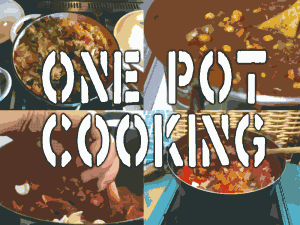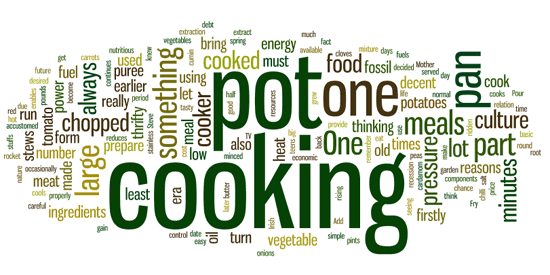We decided to run a thrifty times series for a number of reasons, firstly there is a large scale economic recession gradually developing, set against a bankrupt and debt ridden money market, within the ecological context we are seeing that which take extract from nature in the form of resources being depleted and used up an alarming rate. Being thrifty is about thinking about how we can gain some control over our own resource use by thinking and doing on a local lever
One pot cooking as part of global culture
 One pot cooking is very much part of my upbringing and something which I still do a lot to this day. In the earlier part of my life I grew up in the Salford slums before they were ripped down when I hit my teens. It was in these earlier days that I remember eating a lot of meals that were cooked in a big pan. My Mother used to make us stews made from minced meat root vegetables, and stock, we also had curries occasionally, and that old Irish favourite potatoes ribs and cabbage served up with bread and butter. When ever we had one pot meals we knew that we would always get a decent helping because the ingredients were cheaper for stews and casseroles than a meat and vegetable based cooked dinner.
One pot cooking is very much part of my upbringing and something which I still do a lot to this day. In the earlier part of my life I grew up in the Salford slums before they were ripped down when I hit my teens. It was in these earlier days that I remember eating a lot of meals that were cooked in a big pan. My Mother used to make us stews made from minced meat root vegetables, and stock, we also had curries occasionally, and that old Irish favourite potatoes ribs and cabbage served up with bread and butter. When ever we had one pot meals we knew that we would always get a decent helping because the ingredients were cheaper for stews and casseroles than a meat and vegetable based cooked dinner.
The importance of one pot cooking
For me there are a number of reasons who one pot cooking is important, firstly it enables me to cook something tasty and nutritious for a few pounds which will provide at least half a dozen decent meals which can be frozen and eaten at a later date, and with the price of food constantly rising this form of cooking really is a must if we want to eat properly. With the development of the pressure cooker in relation to one pot cooking, it is possible to cut down cooking time by at least 50% due to the fact that the pressure cooker continues cooking for a while once the power has been switched off.
A simple one pot recipe: basic vegetable curry
- Pour 6 table spoons of oil into your pan and turn onto a low setting.
- Add 2 large chopped onions, 3 cloves of crushed garlic, 1tsp hot chilli power, a teaspoon of cumin powder, 4 cardamom pods, 6 large chopped potatoes, 3 large peeled and chopped carrots, 100grms of red lentils and a tin of chick peas.
- Fry the mixture in the oil for 5 minutes, being careful to insure that none of the ingredients stick to the inside of the pan.
- Then pour 1.5 pints of water into the pan, some sea salt and a good squirt of tomato puree.
- If you are using a pressure cooker, bring it to the boil for 5 minutes and then turn the heat off and let the pan stand with lid on until it cools, if you using a normal stainless steel pan let it cooks for 15 minutes.
- Add more tomato puree for the desired heat and thickness towards the end of the cooking period
The future of one pot cooking
 One pot cooking is thousands of years old, every culture on earth has its own one pot cooking tradition, and it has always been an integral part how we feed and sustain ourselves, and probably always will. As fossil fuel energies run out and their prices rise and we think about how will develop low impact strategies to bring about a more permanent culture, one pot cooking gives us the chance to prepare a whole meal over a single flame, as opposed to a meal made of separate components that requires a lot more fuel to cook it. During the spring and summer I prepare a great many of our meals on a rocket stove in the back garden, which reduces the cost of cooking energy down to zero. One pot cooking is a must in times where both energy and food stuffs are not available in the quantities in which we have become accustomed too during the era of the easy extraction of fossil fuels, and there is also something very human about a gathering of people sitting down round a pot of cooked food, something that has really been lost in the era of TV dinners and takeaways.
One pot cooking is thousands of years old, every culture on earth has its own one pot cooking tradition, and it has always been an integral part how we feed and sustain ourselves, and probably always will. As fossil fuel energies run out and their prices rise and we think about how will develop low impact strategies to bring about a more permanent culture, one pot cooking gives us the chance to prepare a whole meal over a single flame, as opposed to a meal made of separate components that requires a lot more fuel to cook it. During the spring and summer I prepare a great many of our meals on a rocket stove in the back garden, which reduces the cost of cooking energy down to zero. One pot cooking is a must in times where both energy and food stuffs are not available in the quantities in which we have become accustomed too during the era of the easy extraction of fossil fuels, and there is also something very human about a gathering of people sitting down round a pot of cooked food, something that has really been lost in the era of TV dinners and takeaways.
Steve

